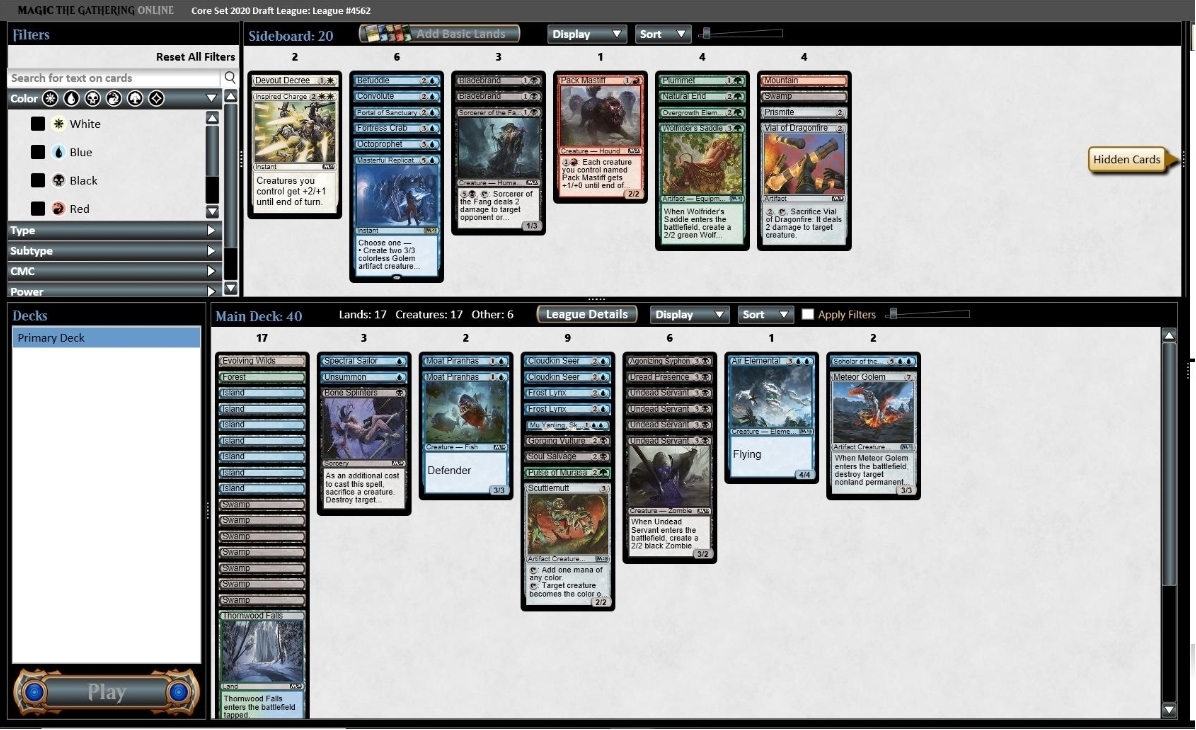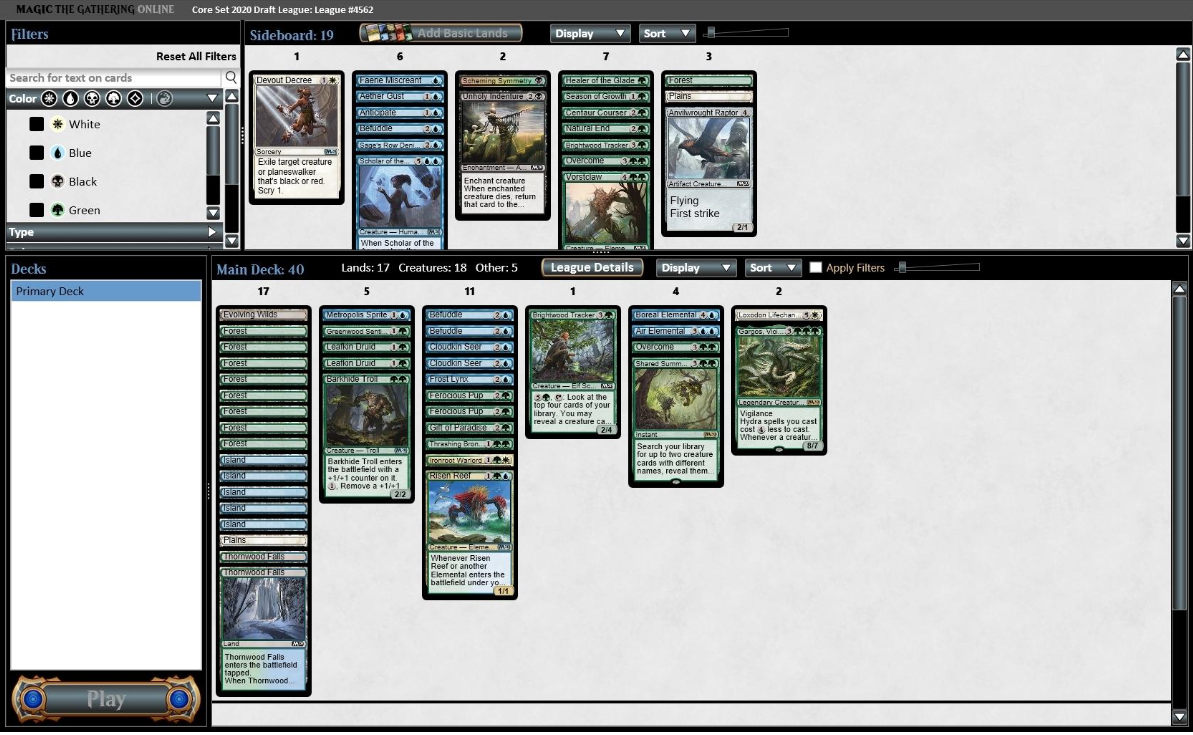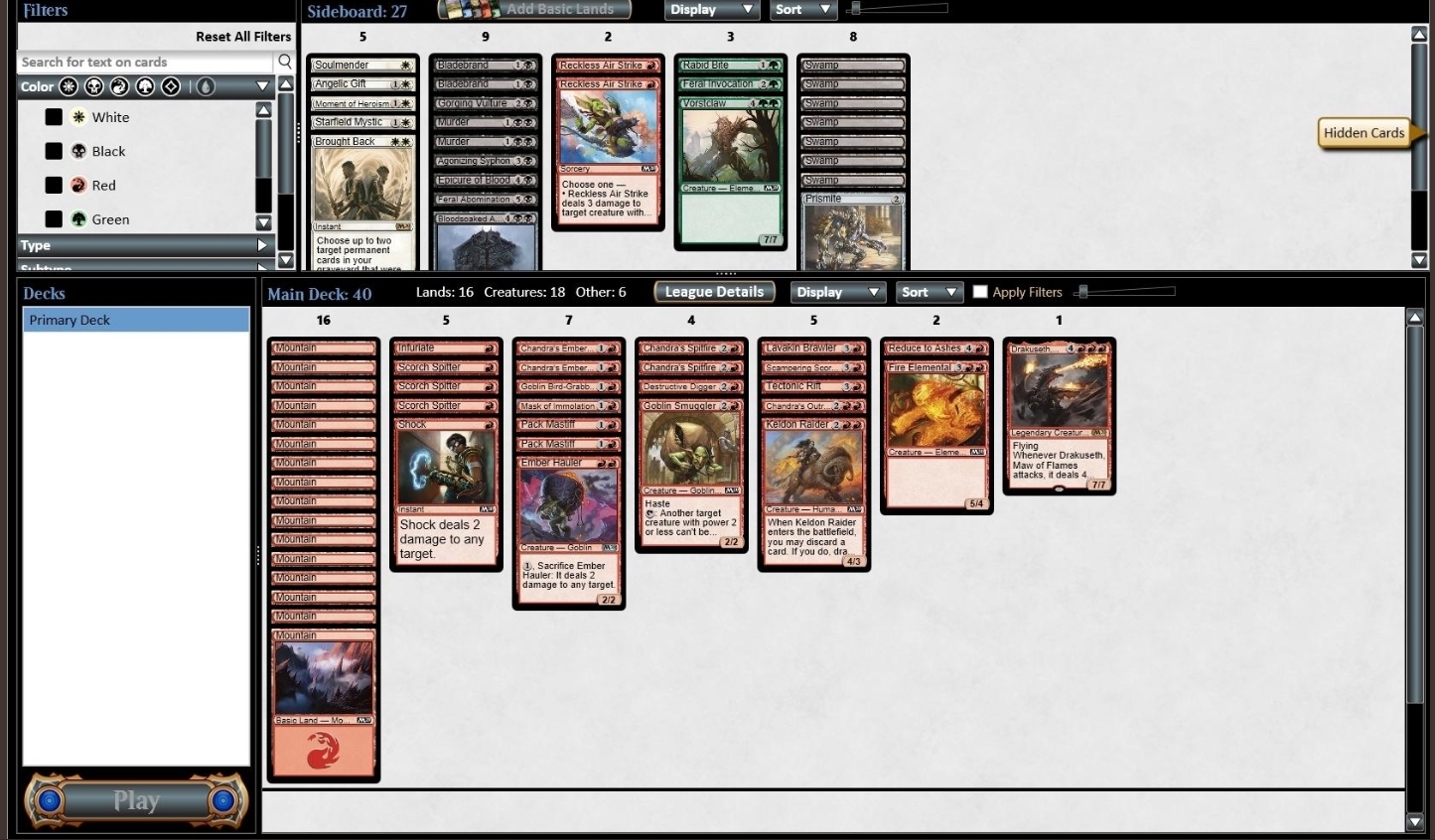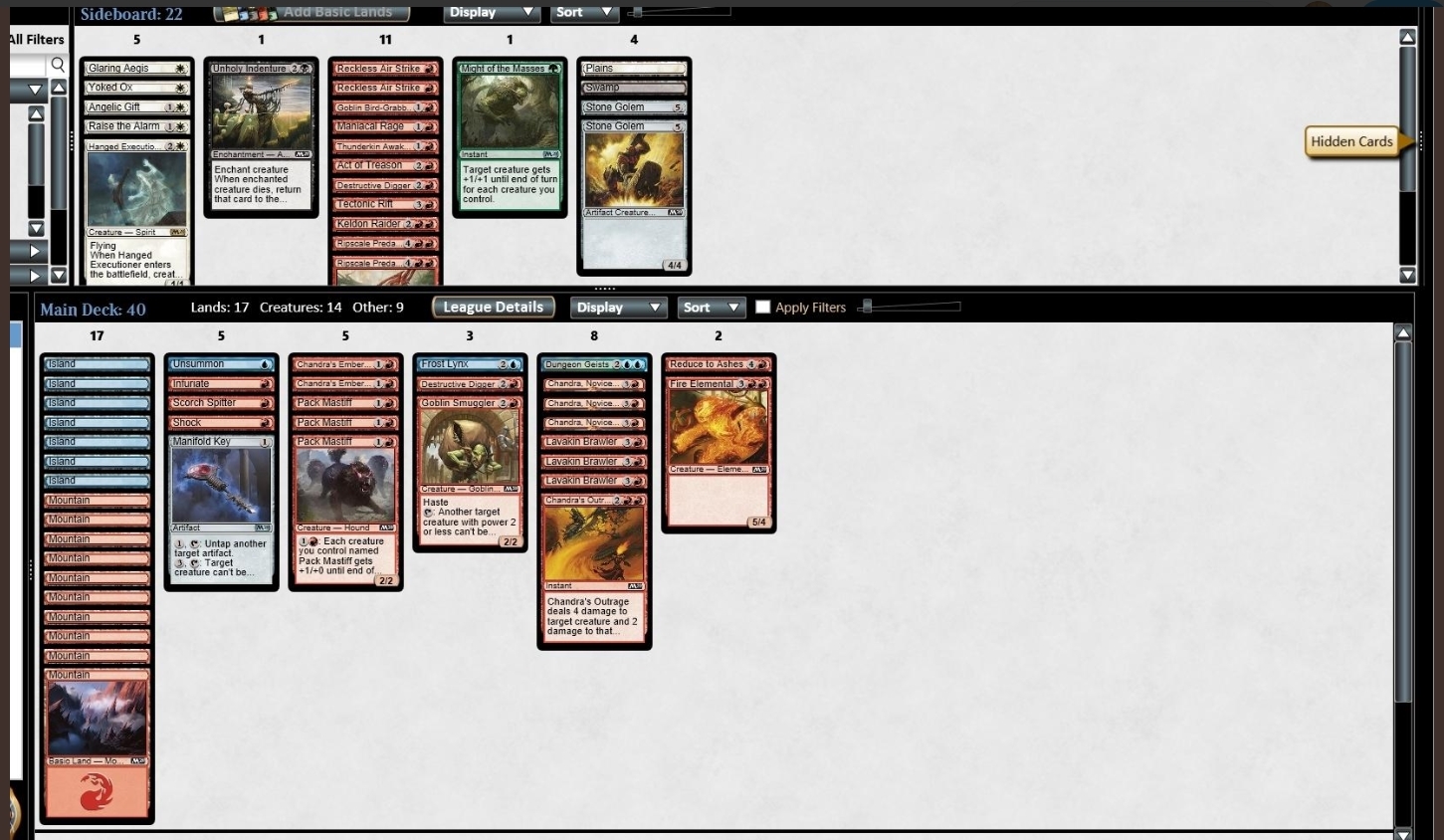
I have to start by giving a huge round of applause to the WotC Set Design and Play Design teams for making the return to core sets a huge success in terms of creating deep and engaging limited environments. M19 certainly had its detractors (I was not one of them, that set was great) but the general consensus for M20 is that it’s the best core set limited environment of all time.
I’m
officially 100 drafts in and each time I crack my packs, I find i'm still presented with interesting decisions in both in the draft and during the games.
One of the things that makes a limited format engaging for me is watching it transform
and discovering how my initial evaluation of cards and archetypes evolve and
change as I play with the set. The items on this list of do’s and don’ts are
reflective of how these evaluations have changed from draft 1 to draft 100.
Many of them highlight my level-up moments in the format, times when I
discovered a leak in how I had been approaching the format and how I
subsequently changed said approach, leading to a better conceptualization of
the format as a whole. Let’s jump in!
Do #1: Do take Cloudkin Seer over Murder P1P1


When I first saw Cloudkin Seer on the day it was previewed, I literally did a double take, zooming in on my phone to make sure that I was reading it correctly. Cloudkin Seer harbors an absurd amount of power for a three-mana common creature. Cloudkin Seer wins the Quadrant Theory test, the entire thing. It’s exactly what you want at every stage of the game. It’s card advantage without tempo loss, it’s a threat, it trades off well, it’s cheap, it generates velocity and, to top it all off it has a set-relevant creature type. I don’t think it’s a stretch to say that it’s the best common printed in a standard set since Mulldrifter in Lorwyn.

Do #1: Do take Cloudkin Seer over Murder P1P1


When I first saw Cloudkin Seer on the day it was previewed, I literally did a double take, zooming in on my phone to make sure that I was reading it correctly. Cloudkin Seer harbors an absurd amount of power for a three-mana common creature. Cloudkin Seer wins the Quadrant Theory test, the entire thing. It’s exactly what you want at every stage of the game. It’s card advantage without tempo loss, it’s a threat, it trades off well, it’s cheap, it generates velocity and, to top it all off it has a set-relevant creature type. I don’t think it’s a stretch to say that it’s the best common printed in a standard set since Mulldrifter in Lorwyn.

As amazing
as Cloudkin Seer reads on first blush, it wasn’t immediately obvious that it
was the best common in the set. In a alot of formats, the best
commons are just the removal spells and with M20 continuing the trend that War
of the Spark started, a return to efficient removal at common, thar seemed
likely to be the case for M20.
Murder is the poster child for efficient removal spells in M20, and a card that I know many players had as the best common going into the set. However, as the format went on, it became clear to many players including me, that even though Murder is very good, Cloudkin Seer just checks too many boxes and is too rawly powerful to not earn the title of best common.
Murder is great, don’t get me wrong (also wow, FBI guy watching my computer, it’s not what it looks like) but there are a good handful of spells in the set that approximate what it does. Pacifism, Chandra’s Outrage, Shock, and Rabid Bite are all great removal spells and while they aren't quite on the level of murder, they fill the same taxonomic role in your deck that Murder does. The reason that Cloudkin Seer gets my vote for the best common is that no other common comes close to what it does and how well it does it. Irreplaceability is a big factor is how highly you should take a given card P1P1 and Cloudkin Seer happens to be at top of its class in that regard. On top of how good the card is in a vacuum, M20 is a particularly kind environment to Cloudkin Seer, as there are a bunch of ways to recur your creatures, and cards that reward you for certain features of the card like the flying/elemental synergy cards.
Murder is the poster child for efficient removal spells in M20, and a card that I know many players had as the best common going into the set. However, as the format went on, it became clear to many players including me, that even though Murder is very good, Cloudkin Seer just checks too many boxes and is too rawly powerful to not earn the title of best common.
Murder is great, don’t get me wrong (also wow, FBI guy watching my computer, it’s not what it looks like) but there are a good handful of spells in the set that approximate what it does. Pacifism, Chandra’s Outrage, Shock, and Rabid Bite are all great removal spells and while they aren't quite on the level of murder, they fill the same taxonomic role in your deck that Murder does. The reason that Cloudkin Seer gets my vote for the best common is that no other common comes close to what it does and how well it does it. Irreplaceability is a big factor is how highly you should take a given card P1P1 and Cloudkin Seer happens to be at top of its class in that regard. On top of how good the card is in a vacuum, M20 is a particularly kind environment to Cloudkin Seer, as there are a bunch of ways to recur your creatures, and cards that reward you for certain features of the card like the flying/elemental synergy cards.
You can take
Murder over Cloudkin Seer P1P1 and you won’t have made a terrible mistake, but
I do think that it is the less powerful card and that you’re giving up some
percentage points by doing so.
Don’t #1: Don’t look to the wedge archetypes to tell you how to draft each colour pair.

efore a set comes out, WotC usually publishes a list of the intended archetypes/ strategies for each colour pair. For M20, they took a pretty novel approach to this, where instead of designing linear strategies around two-colour pairs, the archetypes were more loosely focused and designed around the 5 wedges al la Khans of Tarkir.
The prescribed archetypes are as follows:
Don’t #1: Don’t look to the wedge archetypes to tell you how to draft each colour pair.

efore a set comes out, WotC usually publishes a list of the intended archetypes/ strategies for each colour pair. For M20, they took a pretty novel approach to this, where instead of designing linear strategies around two-colour pairs, the archetypes were more loosely focused and designed around the 5 wedges al la Khans of Tarkir.
The prescribed archetypes are as follows:
·
Flying (blue-red-white)
·
Elementals (green-blue-red)
·
Go Wide (white-black-green)
·
Aggro (red-white-black)
·
Control with "Enters-the-Battlefield" Effects
(black-green-blue)
Most of
these make a lot of sense and play out closely to how they are presented. In
UG, UR and RG, you’re paid off for having a lot of elementals in your deck and
in UB, BG and UG, you want to grind and many of your payoff creatures have
impactful ETB effects. On the surface, it seems the descriptor tells you what
you want to do while drafting and what your deck wants to do, however as you
dig a bit deeper some problems arise.

When I’m learning a new format I want to have a very clear idea of what each colour pair wants to do so that I know where to prioritize certain cards in the draft and figure out what mono colours commons are secretly gold cards (for example, Ferocious Pup isn’t a card I ever really want in RG but it can be a fine role player in GB and WG.) After a few drafts, I realized that the wedge descriptors weren't really giving me what I needed to wrap my head around what each colour pair wanted to do.

GB is a grindy deck with good ETB’s, ok that makes sense, but wait, it also wants to go wide? RW is an aggro deck but also a flying payoff deck? What are my payoffs here? A white removal spells that aggro decks don’t want and a medium at best two drop?



When I’m learning a new format I want to have a very clear idea of what each colour pair wants to do so that I know where to prioritize certain cards in the draft and figure out what mono colours commons are secretly gold cards (for example, Ferocious Pup isn’t a card I ever really want in RG but it can be a fine role player in GB and WG.) After a few drafts, I realized that the wedge descriptors weren't really giving me what I needed to wrap my head around what each colour pair wanted to do.

GB is a grindy deck with good ETB’s, ok that makes sense, but wait, it also wants to go wide? RW is an aggro deck but also a flying payoff deck? What are my payoffs here? A white removal spells that aggro decks don’t want and a medium at best two drop?


The problem here is that some or the enemy pairs are much more aligned with one strategy than others. GB for example is much more “Sultai Grind” than it is “Abzan go wide” and RW is much more of an aggro deck than one centered around flying. To account for this, you need to adjust your picks and evaluations accordingly. If you were drafting M20 for the first time and saw that GB was part of the “go wide” wedge, you might think that a card like Overcome exactly what the deck wants, but that’s usually not the case.
Here’s a quick rundown of what I consider to be the true archetypes for each colour pair
UW: Flying synergy
UB: Grindy Control/ Scholar of the ages loop decks
UG: Elementals/a base for 3-5 colour good stuff
UR: Aggro/Tempo, the only real Elemental payoff is Lavakin brawler and the only flying payoff is Winged Words, don’t focus too hard on either theme, just have a solid aggressive deck
BG: Grindy control, Mouldervine Reclamation.dec
BW: Go wide with Corpse Knight and Gruesome Scourger as payoffs or lifegain matters (reliant on uncommon payoffs to be good)
RW: Go wide aggro, raise the alarm based
GW: Go wide aggro, raise the alarm based
BR: Midrange grind. Not really an aggro deck. Good removal but black’s threats are generally weak, the deck can be more aggressive if you are red based
RG: Elementals with the highest density of payoffs
Do #2: Do take the X and Y colour hoser cards higher than you are now
M20 presents
us with this cycle of extremely powerful colour hosing spells





A month into the format, these cards are still going close to last in too many MTGO pods. It seems that most people are taking these cards in the spot where they would take traditional sideboard cards like Disenchant or Shatter ( or possibly just taking middling maindeck playables over them) but you can meaningfully improve your card pool by ending up with 3-4 of these cards in your sideboard. Being able to bring in a couple A-level removal spells in relevant matchups grants a gigantic boon to your win percentage.
I’m taking these cards above C level playables in pack 1 and 2, and then above C plus/ Some B minus cards in pack 3 once you know for sure what colours you’re in. Remember, at least 50 percent (and on average, more than that) of your games are played post sideboard. Having a strong main deck is important but don’t underestimate the power of having a strong post-board plan.
Don’t #2: Don’t play the Cavaliers ( or other hard to cast cards) if your manabase can’t afford them

The cycle of elemental Cavaliers are some of the most powerful cards in the set, but as a foil to that, they’re costed accordingly. To play them responsibly, you need at very least 9 sources of the requisite colour needed to cast them, and ideally 10-12 if you want to cast them on turn 5. If you don’t meet that requirement, you should seriously consider not including them in your deck, as you risk not being able to cast them in a timely fashion. Conversely, if the rest of your deck is mainly a colour that the Cavalier is not, you can’t afford to play a bunch of lands that don’t cast the majority of your spells to try to accommodate your sweet mythic. This also applies to the CCC cycle of rares in M20 (Gargos, Villis, etc.)

This deck from Twitter user @KaptainMeliodas really illustrates this point. There’s no way that they could have put more blue sources into their deck without royally messing with their ability to cast their red spells, meaning the Cavalier stays int he board. Limited manabases are poor by nature, putting additional stress on them with irresponsible builds usually loses you more EV than it gains.
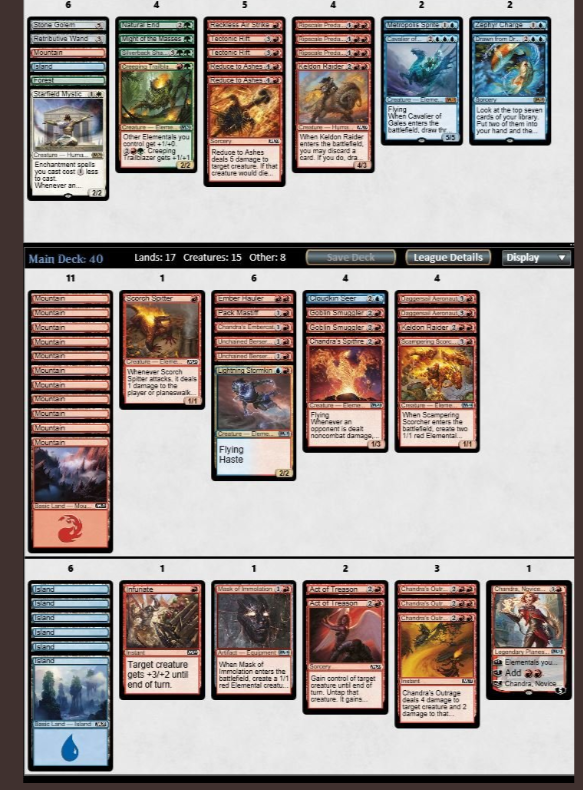
Do #3: Do pick dual lands and evolving wilds over C level playables

Trailing off of the previous “don’t” point, limited mana bases inherently are much worse than most people give them credit for. The standard 8-9 split manabase has you drawing lands and spells that don’t match an alarming amount of the time (I highly recommend checking out Frank Karsten’s articles about building manabases if you want to check out the numbers and haven’t already)
M20 blesses us with fixing at common that doesn’t take up a spell slot. Take advantage of this





A month into the format, these cards are still going close to last in too many MTGO pods. It seems that most people are taking these cards in the spot where they would take traditional sideboard cards like Disenchant or Shatter ( or possibly just taking middling maindeck playables over them) but you can meaningfully improve your card pool by ending up with 3-4 of these cards in your sideboard. Being able to bring in a couple A-level removal spells in relevant matchups grants a gigantic boon to your win percentage.
I’m taking these cards above C level playables in pack 1 and 2, and then above C plus/ Some B minus cards in pack 3 once you know for sure what colours you’re in. Remember, at least 50 percent (and on average, more than that) of your games are played post sideboard. Having a strong main deck is important but don’t underestimate the power of having a strong post-board plan.
Don’t #2: Don’t play the Cavaliers ( or other hard to cast cards) if your manabase can’t afford them

The cycle of elemental Cavaliers are some of the most powerful cards in the set, but as a foil to that, they’re costed accordingly. To play them responsibly, you need at very least 9 sources of the requisite colour needed to cast them, and ideally 10-12 if you want to cast them on turn 5. If you don’t meet that requirement, you should seriously consider not including them in your deck, as you risk not being able to cast them in a timely fashion. Conversely, if the rest of your deck is mainly a colour that the Cavalier is not, you can’t afford to play a bunch of lands that don’t cast the majority of your spells to try to accommodate your sweet mythic. This also applies to the CCC cycle of rares in M20 (Gargos, Villis, etc.)

This deck from Twitter user @KaptainMeliodas really illustrates this point. There’s no way that they could have put more blue sources into their deck without royally messing with their ability to cast their red spells, meaning the Cavalier stays int he board. Limited manabases are poor by nature, putting additional stress on them with irresponsible builds usually loses you more EV than it gains.

Do #3: Do pick dual lands and evolving wilds over C level playables

Trailing off of the previous “don’t” point, limited mana bases inherently are much worse than most people give them credit for. The standard 8-9 split manabase has you drawing lands and spells that don’t match an alarming amount of the time (I highly recommend checking out Frank Karsten’s articles about building manabases if you want to check out the numbers and haven’t already)
M20 blesses us with fixing at common that doesn’t take up a spell slot. Take advantage of this
opportunity and strive to build a good manabase. Having 2-3
dual lands in your deck improves your manabase substantially, meaning
succumbing to variance less often and even having to mulligan less.
Don’t #3: Don’t mis-evaluate these cards
Don’t #3: Don’t mis-evaluate these cards
I
specifically bring up these cards because I see them go later than they should
(by a lot in some cases)
Mask of immolation: This card is great, and I’ve seen in wheel in pack 1 with some amount of consistency which should basically never happen. Mask does a lot of small things that add up to one very good card. The initial ping usually kills a small creature and from there you can use your more irrelevant creatures to kill fliers or just finish off your opponent. In addition to its surface level uses, the card really loves Chandra’s Spitfire, Sanitarium Skeleton, and Act of Treason. I take my first Mask over my first Shock/Chandra’s Outrage, it’s on power level with the removal spells but is less replaceable

Chandras Regulator: A lot of early set reviews poo-poo’d this one, but in a deck with 9 + mountains, the card does a good Merfolk Looter impression and with 2 Chandras in the set trinket text comes up a good amount

Loxodon Lifechanter: I think the secret is mostly out on this one but a bit earlier in the format I was getting passed this card in pack 1. This card is busted good and even if you have an aversion to white, it’s a great splash card.

Golos: I would say the secret about Golos is also out but this one I do still get passed to me in pack 1. Golos is great and worth building around, one activation is usually game over and a lot of decks will play him even if they can’t activate him.

Bag of holding: This is just a good card advantage engine; I have this as better than every common/uncommon P1P1 except Chandra Novice Pyromancer (Risen Reef is up there too but colourless>gold)

Mask of immolation: This card is great, and I’ve seen in wheel in pack 1 with some amount of consistency which should basically never happen. Mask does a lot of small things that add up to one very good card. The initial ping usually kills a small creature and from there you can use your more irrelevant creatures to kill fliers or just finish off your opponent. In addition to its surface level uses, the card really loves Chandra’s Spitfire, Sanitarium Skeleton, and Act of Treason. I take my first Mask over my first Shock/Chandra’s Outrage, it’s on power level with the removal spells but is less replaceable

Chandras Regulator: A lot of early set reviews poo-poo’d this one, but in a deck with 9 + mountains, the card does a good Merfolk Looter impression and with 2 Chandras in the set trinket text comes up a good amount

Loxodon Lifechanter: I think the secret is mostly out on this one but a bit earlier in the format I was getting passed this card in pack 1. This card is busted good and even if you have an aversion to white, it’s a great splash card.

Golos: I would say the secret about Golos is also out but this one I do still get passed to me in pack 1. Golos is great and worth building around, one activation is usually game over and a lot of decks will play him even if they can’t activate him.

Bag of holding: This is just a good card advantage engine; I have this as better than every common/uncommon P1P1 except Chandra Novice Pyromancer (Risen Reef is up there too but colourless>gold)

Do #4: Do
take Pattern Matcher early and play it even with one match

Pattern matcher is a card I’m happy to take early out of a pack that doesn’t have any premium commons or uncommons. Four mana 3/3 is a reasonable stat-line in this format and drawing a card off this card is pretty common with just a little bit of good deck building.
Playing pattern matcher with only one potential match in your deck is still fine, as drawing a card from it is such high upside, and the floor of the card isn’t embarrassing.

Pattern matcher is a card I’m happy to take early out of a pack that doesn’t have any premium commons or uncommons. Four mana 3/3 is a reasonable stat-line in this format and drawing a card off this card is pretty common with just a little bit of good deck building.
Playing pattern matcher with only one potential match in your deck is still fine, as drawing a card from it is such high upside, and the floor of the card isn’t embarrassing.
Don’t #4:
Don’t be ROTY about Rotting Regisaur


Rotting Regisaur has created more polarizing opinions than any other card I can remember. I’ve heard players whose opinions I respect say that the card is a P1P1 over every common and uncommon, and others saying its hot garbage. This discrepancy of opinions makes sense as how good the card varies greatly from game to game. Sometimes you play it on turn 3 and you opponent loses on turn 6 and sometimes it gets Pacified and you basically lose on the spot.
I’ve personally landed somewhere in the middle on the card. I take it early and almost always include it in my deck with the understanding that it will lose me the game sometimes and that’s ok. Whether you decide to draft/play Rotting Regisaur is up to you, but the important thing to remember is that when you put the card in your deck, you’re accepting that the card has a massive range for how well it performs and that its neither amazing nor awful based on the small sample of games you play with it. Just like every card we evaluate, Rotting Regisaur should be evaluated based on its floor and ceiling and is never a fixed point on that scale.
Do #5: Do draft white when it’s open
I think white kind of got a bad rap early in the format that it never quite shook. It’s certainly the worst colour in the format but by a fair margin, but it’s not quite at the “avoid at all costs” level where I’ve seen some people have it. White’s commons are under-powered when compared to the other colours, but it is among the strongest colours when you look at the higher rarity cards.


I’m not looking to move into white early, but if I’m seeing quality cards like Griffin Protector wheeling, I’ll make some late speculative white picks and see if I get passed some of the better cards in later packs. White being perceived as awful is a boon for drafters willing to speculate on it as you’ll often get passed A level cards from people that are trying to avoid the colour at all costs.

Since white is bad at attacking on the ground, a successful white deck needs to be at least one of the following things
1. A Raise the Alarm style deck with anthem effects
2. A deck that has white as its secondary colour, cherry picking the best cards from the colour (Pacifism, good uncommons/rares)
3. A deck that lucks out and just has very high card quality (usually meaning you’re the only white drafter at the table, which happens semi-regularly
Don’t #5: Don’t be Midrange
If you’ve
listened to Lords of Limited, this is something that you’ve already heard, but
I do want to echo it here. M20 has insanely powerful deck at both ends of the spectrum;
Mono-red decks that are looking to kill you on turn 5 and Decks that want to
grind until turn 15 and lock you out of the game by looping Scholar of the
Ages.
Being caught somewhere in the middle isn’t somewhere that I’m really looking to be if I can help it. This isn’t to say that midrange decks can’t be good, more that for them to compete with decks on either end of the spectrum, they need high card quality to not just get demolished by a deck with a more streamlines plan.
Being caught somewhere in the middle isn’t somewhere that I’m really looking to be if I can help it. This isn’t to say that midrange decks can’t be good, more that for them to compete with decks on either end of the spectrum, they need high card quality to not just get demolished by a deck with a more streamlines plan.
I leave you dear reader with my M20 card rankings from 17lands.com for anyone who wants to compare card evaluations. It’s a great tool and I highly recommend using it. https://www.17lands.com/card_tiers/shared/371b8cbf6c864cbcb330c1273fd5271f


